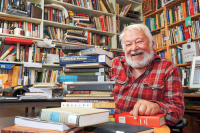Parks and rec grants decrease across state
Macon County can count itself lucky for landing a $500,000 state recreation grant to help pay for a softball and baseball complex.
The N.C. Parks and Recreation Trust Fund was cut by more than half last year. While the latest cuts by the Republican-controlled General Assembly were the most significant yet, it has gradually been shrinking in size since the recession. The parks and rec trust fund has been cut by 80 percent since 2007.
The highly coveted grant pool makes recreation projects more affordable and palatable for local communities to tackle. Greenways, swimming pools, riverside picnic areas, a skate park and ball fields have been built over the past decade in Haywood, Jackson, Macon and Swain counties thanks to the grants that offset the local cost.
But the grant pool was slashed from $10 million in 2012 to only $4 million in 2013. And the number of grants awarded shrunk from 47 in 2012 to 14 in 2013.
Perhaps more troubling to local governments that have come to count on the grant pool is the trust fund’s insecurity and volatility going forward.
Related Items
The trust fund used to have a guaranteed revenue stream pouring into it each year. A state tax on real estate transactions was funneled directly into the parks and rec trust fund.
That was changed by the General Assembly last year. Now, the tax on real estate transactions goes straight to the state’s general coffers. That leaves the park and rec trust fund without a guaranteed revenue stream. Instead, it’s up to state lawmakers to decide how much to put in the trust fund from year to year.
“They unhooked the parks and rec trust fund from the real estate tax revenue stream and made it its own appropriation,” explained Charlie Peaks, spokesperson for the N.C. Division of Parks and Recreation.
Granted, having its wagon hitched to a real estate tax made the fund vulnerable. It dropped by 50 percent from 2006 to 2010 simply due to the drop in real estate buying and selling. But it gained back 25 percent of its former value from 2010 to 2012 before the dramatic cuts last year by lawmakers.
But even in a real estate slump, the funding level fared better than it did in the hands of last year’s General Assembly.
One thing that hasn’t changed: demand for the grants from local communities. The number of applications has held steady at 70 or more a year. The grants aren’t free money. Counties and towns have to put up sizeable funds of their own, equal to or more than the amount of the grant.
But their willingness to pony up for parks and recreation didn’t wane even as counties and towns suffered from the same recessionary woes as the state.
“What was startling to us was when the bottom dropped out of the real estate market, there was no drop in applications,” Peek said. “These local communities were still willing to come up with the matching funds even though it was in the recession.”
Statewide, the trust fund has doled out $173 million for 768 projects over the past 25 years.
WNC loses representation
Another change made to the parks and rec trust fund by state lawmakers last year was a shake-up to the board that decides on grant funding.
The old board had three members from the 23 western counties. The new board only has one.
The beach did not see a loss in representation. It had three members under the old board, and still has three.
Meanwhile, the Charlotte area picked up representation: it now has three members on the board instead of one. The board overall was reduced from 14 to nine.
Reasons for the shake-up are unclear, other than the new Republican majority in Raleigh wanting to get rid of old board members and appoint new ones of its own choosing.
Rather than wait for the seats on the trust fund board to come up for appointment and name new members in an organic fashion over time, state lawmakers simply abolished the board and created a new one.
This pattern played out more than once.
“That happened with a variety of boards and commissions,” said Bill Ross, an environmental attorney in Chapel Hill who used to be the chair of the parks and rec board but was kicked off in the overhaul.
Ross wouldn’t speculate on why, other than a general change in the political direction.
“The answer lies behind whatever the motive was behind that bigger picture,” Ross said.
John Stevens, an attorney in Asheville who also lost his seat on the trust fund board, said the work of the parks and rec trust fund had never been politicized.
“Politics is never an issue, so I am at a loss as to why the legislature did what it did. It could simply be they wanted to put in their own people,” said Stevens.
Only three members from the old board survived the shake-up and were renamed to the new board.
What else it does?
The parks and rec trust fund does more than fund local recreation projects. The majority of the trust fund allocations — two-thirds to be exact — are earmarked for state park projects.
The trust fund is used to buy land to add to existing state parks, or to create new state parks and natural areas.
And some of the state park money is used for projects at existing parks, like campgrounds, visitor centers, boat docks, fishing piers, picnic areas, new trails and so on.
State Parks and Recreation Trust Fund revenue
2006: $45 million
2010: $25 million*
2011: $27 million
2012: $33 million
2013: $11 million**
* Drop in funding due to drop in real estate transactions during the recession. A tax on real estate transactions provided the trust fund’s revenue stream.
** Drop in funding reflects cuts by the General Assembly. Real estate tax no longer a dedicated revenue stream for the trust fund.









